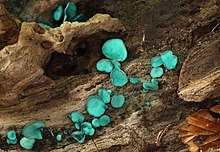|
Chlorociboria
Chlorociboria is the type genus of in the fungal family Chlorociboriaceae within order Helotiales. The genus includes 23 species.[1] Two common temperate zone species, Chlorociboria aeruginascens and Chlorociboria aeruginosa, can only reliably be distinguished by microscopic examination. Chlorociboria aeruginosa has larger spores (9–15 μm × 1.5–2.5 μm) and the worm-like cells of the outer surface are rough, unlike the commoner C. aeruginascens, of which the spores are 6–10 μm × 1.5–2 μm. The hyphae and fruit bodies of all species make xylindein, a secondary metabolite that stains the substrate wood blue-green, with "green oak" being a valued commodity in woodworking.[2] The blue-green pigmented wood is featured in Tunbridge ware. HabitBlue-green stain is evident year-round, with ascocarp production occurring from summer to fall. Species
See alsoReferences
External links
|
||||||||||||||||||||||||||||||
